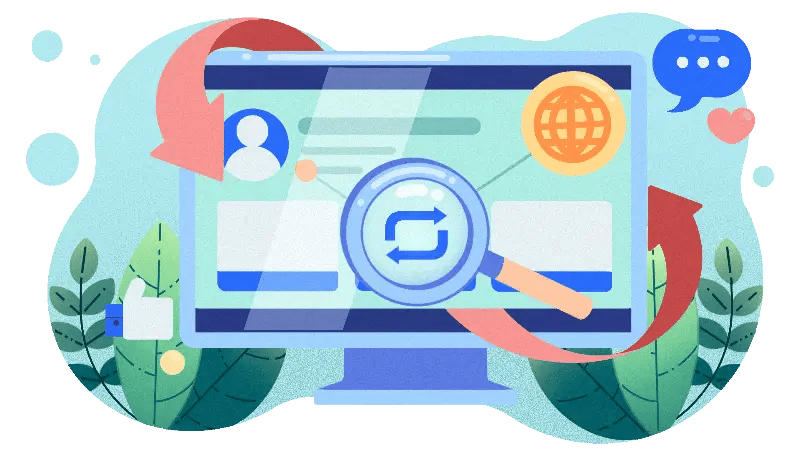
Is your website a revolving door? Visitors come and go, but few become paying customers. It’s a common problem, but a solvable one. This is where conversion rate optimization (CRO) comes in–it’s the practice of turning website visitors into loyal customers. Without it, you’re leaving money on the table.
Let’s dive into some common CRO mistakes that could be plaguing your business.
Mistake 1: Neglecting Mobile Optimization
We live in a mobile-first world. Think about it–how often do you reach for your phone to browse the internet? If you’re like most people, it’s probably your primary device. Statistics back this up: in 2023, mobile devices generated over 58% of global website traffic. Ignoring mobile optimization is a critical error.
A poor mobile experience frustrates users. Tiny fonts, slow loading times, and clunky navigation all contribute to high bounce rates, low engagement, and, ultimately, fewer conversions. Imagine trying to navigate a website designed for a desktop on your small phone screen. Annoying, right? That’s how your customers feel when your site isn’t mobile-friendly.
The Solution: Optimize for Mobile
Fortunately, the fix is straightforward. First, ensure your website utilizes a responsive design that adapts seamlessly to any screen size. This means your site will automatically adjust its layout and content to look good and function correctly on desktops, tablets, and smartphones. Next, prioritize page load speed. Mobile users are notoriously impatient–even a one-second delay can significantly impact conversions. Finally, make sure your mobile site is easy to navigate. Use clear menus, prominent call-to-action buttons, and a search bar to help visitors quickly find what they’re looking for.
Take, for instance, the fashion retailer ASOS. They invested heavily in mobile optimization, creating an app, and streamlining their mobile site. The result? A significant increase in mobile conversions and overall revenue. Don’t let a subpar mobile experience drive your customers away.
Mistake 2: Confusing Website Navigation
Think of your website navigation as a roadmap guiding visitors to their destination. If the map is confusing and poorly designed, your visitors will get lost and frustrated. Intuitive website navigation is crucial for a positive user experience. When visitors can easily find what they’re looking for, they’re more likely to stay engaged, explore your site, and ultimately convert.
Conversely, poor navigation leads to confusion and frustration. Imagine landing on a website with a cluttered menu, ambiguous labels, and no clear path to the information you need. You’d likely leave in a hurry, right? That’s exactly what happens when your website navigation is unclear. It increases bounce rates, decreases time on site, and negatively impacts your conversion rates.
The Solution: Prioritize UX
To ensure your website navigation is user-friendly, start with clear and concise menu labels. Use terms your audience understands and organize your menu logically. A well-placed search bar is another essential element. It allows visitors to quickly find specific products, services, or information without clicking through multiple pages. Finally, implement breadcrumbs. These navigational aids show users their current location within the site’s hierarchy, making it easy to backtrack or explore related pages.
A great example of the power of good navigation is the online retailer Etsy. They redesigned their website with a focus on simplified navigation, improved search functionality, and clear category pages. This resulted in a significant increase in user engagement and a noticeable boost in sales. By prioritizing intuitive navigation, Etsy made it easier for customers to find and purchase the products they love.
Mistake 3: Unclear Call-to-Actions (CTAs)
Call-to-actions (CTAs) are essential for guiding users toward conversion. They are the bridge between a visitor browsing your site and taking that next step to become a customer. However, a weak or unclear CTA can be a major roadblock. If your CTAs are vague, confusing, or blend in with the rest of your website, visitors may not understand what you want them to do next.
This leads to hesitation, confusion, and ultimately, lost opportunities. Imagine a visitor interested in your product but unable to find the “Buy Now” button or unsure what will happen when they click a vaguely worded link. That’s a potential customer slipping away.
The Solution: Clear, Concise CTAs
Effective CTAs share common characteristics. They use clear, concise language that leaves no room for ambiguity. Instead of a generic “Submit” button, opt for action-oriented verbs like “Shop Now,” “Download Your Guide,” or “Get Started Today.” Visually, CTAs should stand out from the surrounding content. Experiment with button colors, sizes, and placement to capture attention.
To optimize your CTAs, start by using strong action verbs that clearly communicate the desired action. Don’t be afraid to experiment with different colors, sizes, and placement of your CTA buttons. A/B testing is your best friend here. Try different variations of your CTAs to see which ones resonate best with your audience and drive the most conversions.
Mistake 4: Overlooking A/B Testing
Guesswork is the enemy of conversion rate optimization. Without concrete data to guide your decisions, you’re essentially throwing darts in the dark and hoping for the best. Overlooking A/B testing means missing out on valuable insights into user behavior and preferences. It’s like trying to navigate a maze without a map–you might eventually find your way out, but it will take longer and involve a lot of wrong turns.
Many businesses make the mistake of assuming they know what their audience wants. They implement changes based on intuition or personal preferences rather than testing and analyzing different options. This can lead to ineffective website design, confusing content, and, ultimately, lower conversion rates. A/B testing removes the guesswork and allows you to make data-driven decisions that improve website performance.
The Solution: Test, Test, Test
To effectively implement A/B testing, start by identifying key elements to test. Headlines, images, CTAs, and forms are all excellent candidates. Utilize A/B testing tools like Google Optimize or Optimizely to streamline the process and analyze results. Remember, A/B testing is an ongoing process. Continuously iterate and improve your website based on the insights you gather.
The benefits of A/B testing are numerous. It empowers you to make decisions based on real user behavior, not hunches. By continually testing and refining different elements, you can identify what resonates best with your audience, leading to improved website performance and increased conversions. Think of it as a scientific approach to website optimization.
Mistake 5: Ignoring Analytics
Ignoring website analytics is like operating a business without a financial report. You wouldn’t make critical decisions about your budget or investments without understanding your income and expenses, would you? Website analytics provide the data you need to make informed decisions about your online strategy and measure the effectiveness of your CRO efforts.
These analytics offer valuable insights into how visitors interact with your website. By tracking key metrics like conversion rates, bounce rates, time on page, and traffic sources, you can identify areas for improvement and optimize your site for better results. Without this data, you’re essentially guessing what works and what doesn’t, potentially wasting time and resources on ineffective strategies.
The Solution: Data-Driven Decision Making
To harness the power of analytics, start by setting up Google Analytics (or a similar tool) on your website. This free platform provides a wealth of data about your visitors and their interactions with your site. Make it a habit to regularly analyze this data, looking for trends, patterns, and areas of concern.
For example, if you notice a high bounce rate on a particular page, it could indicate a problem with the content, design, or user experience. Use the insights gleaned from your analytics to inform your conversion rate optimization strategies and decisions. Instead of relying on guesswork, let the data guide your optimization efforts.
Mistake 6: Slow Page Load Speed
We live in a world of instant gratification. When it comes to website browsing, users expect speed and efficiency. If your page takes too long to load, you risk losing potential customers before they even see your content. Studies show that even a one-second delay in page response can result in a 7% reduction in conversions. Slow loading times lead to frustration, high bounce rates, and, ultimately, lost revenue.
Imagine waiting in line at a store with only one cashier working at a snail’s pace. How long would you wait before getting frustrated and leaving? Your website visitors have a similar level of patience. They want a seamless and efficient browsing experience. A slow website not only impacts conversions but also damages your brand reputation and SEO rankings.
The Solution: Optimize for Speed
Fortunately, there are several ways to improve your website’s speed. Start by optimizing your images and videos. Large file sizes are a major culprit of slow loading times. Compress your images and use modern image formats like WebP for optimal performance. Consider using a Content Delivery Network (CDN). A CDN stores your website’s files on servers worldwide, allowing visitors to access your site from the server closest to their location, reducing latency and improving loading times.
Another effective strategy is to minimize HTTP requests and leverage browser caching. Each element on your webpage (images, scripts, stylesheets) requires a separate HTTP request, which can slow down loading times. Minimize these requests by combining files and using CSS sprites. Browser caching allows repeat visitors to load your website faster by storing certain elements in their browser’s cache.
Mistake 7: Not Building Trust and Credibility
Online shoppers are savvy. They know the internet is full of scams and unreliable businesses. Before making a purchase, they need reassurance that your website is legitimate and trustworthy. This is where trust signals come into play. Trust signals are elements on your website that build credibility and inspire confidence in potential customers. Without them, visitors may hesitate to provide their personal information or complete a purchase.
Think about it. Would you feel comfortable buying from a website with no contact information, no customer reviews, and no security badges? Probably not. Trust signals are essential for overcoming skepticism and encouraging conversions. They tell visitors that your business is legitimate, reliable, and committed to customer satisfaction.
The Solution: Build a Trustworthy Website
There are several effective trust signals you can implement on your website. Start by displaying customer testimonials and reviews. Positive feedback from previous customers acts as social proof, demonstrating the value and reliability of your products or services. Showcase security badges and trust seals from reputable organizations like Norton or McAfee. These badges assure visitors that their personal and financial information is safe on your site.
Offering guarantees and easy return policies is another way to build trust. It shows confidence in your products and demonstrates a commitment to customer satisfaction. Finally, make sure your contact information is clearly displayed and provide excellent customer support. Being readily available to answer questions and address concerns goes a long way in building trust and credibility.
Don’t Let CRO Mistakes Hold You Back
We’ve covered a lot of ground in this post, exploring common CRO mistakes that can hinder your website’s success. From neglecting mobile optimization to ignoring analytics, these pitfalls can significantly impact your conversion rates and bottom line. By addressing these issues and implementing the suggested solutions, you can create a website that is truly optimized for conversions.
Remember, your website is your most valuable online asset. It’s your 24/7 salesperson, working tirelessly to attract and convert visitors. Don’t let these common mistakes sabotage your online success. Take action today! Start by identifying any areas where your website might be falling short. Then, implement the strategies outlined in this post to create a user-friendly, engaging, and high-converting online experience.
Ready to boost your conversions? Partner with Aspiration Marketing and unlock your website’s full potential!










